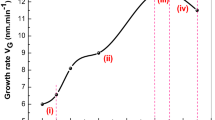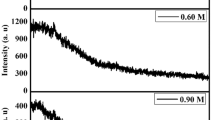Abstract
In the present work, we have successfully deposited cadmium sulfide (CdS) thin films with quantum dot size on a silica glass substrate by using simple and commercial chemical bath deposition (CBD) with varying the concentration of the solution at ~ 50 °C bath temperature, where we found that the deposition parameters such as the precursor ratio of cadmium and thiourea strongly influence the morphology, physical properties, and photoresponse. There has been a disparity in the proportion of the equivalent elements of the precursors, where the stoichiometric ratio of Cd/S of the precursor was changed, which allows us to understand more about the conditions and influences on growth. There was a match when comparing standard Joint Committee on Powder Diffraction Standards (JCPDS) data with the study of X-ray diffraction and confirming the formation of a hexagonal crystal structure for CdS where is observed the size of the crystal varied and it was found that the estimated average of the CdS varied with the varying concentration and resulted in the least crystallite size of ~ 2.9 nm for the ratio of 0.01 M for cadmium and 0.02 M for sulfur. The field emission scanning electron microscopy (FE-SEM) images show the formation of nanosheets having micrometer-sized petals which got uniformity with varying Cd/S ratio. It can be seen absorption spectra near band edge ~ 400 nm with a slight deviation and presence of an excitonic peak for all samples with an estimated bandgap of CdS Quantum Dot (QD) thin films found to be varying from ~ 3.124 to ~ 3.11 eV. The photosensitivity was calculated for all CdS QD thin films and it was found that the photosensitivity increases with an increase in the Cd/S ratio.







Similar content being viewed by others
References
D. Saikia, P. Phukan, Fabrication and evaluation of CdS/PbS thin film solar cell by chemical bath deposition technique. Thin Solid Films 562, 239–243 (2014)
J. Zhao et al., Efficient CdSe/CdS quantum dot light-emitting diodes using a thermally polymerized hole transport layer. Nano Lett. 6(3), 463–467 (2006)
R. Banerjee, R. Jayakrishnan, P. Ayyub, Effect of the size-induced structural transformation on the band gap in CdS nanoparticles. J. Phys. Condens. Matter 12, 10647 (2000)
L. Fan et al., Improved stoichiometry and photoanode efficiency of thermally evaporated CdS film with quantum dots as precursor. Nanotechnology 26(33), 335606 (2015)
U. Pal et al., Optical characterization of vacuum evaporated cadmium sulfide films. Thin Solid Films 305(1–2), 345–350 (1997)
L. Hu et al., High performance PbS colloidal quantum dot solar cells by employing solution-processed CdS thin films from a single-source precursor as the electron transport layer. Adv. Funct. Mater. 27(46), 1703687 (2017)
S. Aydin Yuksel, S. Gunes, H.Y. Guney, Hybrid solar cells using CdS thin films deposited via spray pyrolysis technique. Thin Solid Films 540, 242–246 (2013)
M. Tomakin et al., Preparation and characterization of new window material CdS thin films at low substrate temperature (< 300 K) with vacuum deposition. Mater. Sci. Semicond. Process. 14(2), 120–127 (2011)
J.H. Kim et al., Properties of CdS quantum dots synthesized using sonochemical successive ionic layer adsorption and reaction method for quantum dot-sensitized solar cells. J. Phys. Chem. Solids 127, 101–106 (2019)
S.U. Shaikh et al., Effects of air annealing on CdS quantum dots thin film grown at room temperature by CBD technique intended for photosensor applications. Mater. Res. Bull. 47(11), 3440–3444 (2012)
V.S. Taur, R.A. Joshi, R. Sharma, Annealing-induced modifications in physicochemical and optoelectronic properties of Ag-doped nanostructured CdS thin films. Int. J. Photoenergy 2012, 1–7 (2012)
F.Y. Siddiqui et al., Band gap engineering by substitution of S by Se in nanostructured CdS1–xSex thin films grown by soft chemical route for photosensor application. Mater. Sci. Semicond. Process. 27, 404–411 (2014)
J. Barman, J. Prasad Borah, K. Sarma, Effect of pH variation on size and structure of Cds nanocrystalline thin films. Chalcogenide Lett. 5, 265–271 (2008)
A. Kariper et al., Effect of pH on the physical properties of CdS thin films deposited by CBD. Chalcogenide Lett. 9, 27–40 (2012)
Y. Lei et al., Solvothermal synthesis of CdS–graphene composites by varying the Cd/S ratio. Ceram. Int. 41(2B), 3158–3161 (2015)
M. Thambidurai et al., Influence of the Cd/S molar ratio on the optical and structural properties of nanocrystalline CdS thin films. J. Mater. Sci. Technol. 26(3), 193–199 (2010)
M. Waldiya et al., Nanoparticulate CdS 2D array by chemical bath deposition: characterization and optoelectronic study. Mater. Chem. Phys. 226, 26–33 (2019)
M. Fathy et al., Effect of CdCl2 concentration and heat treatment on electrodeposited nano-crystalline CdS thin films from non-aqueous solution. Int. J. Electrochem. Sci. 9, 6155–6165 (2014)
M. Husham et al., Nanocrystalline CdS thin films growth on silicon substrates via microwave assisted chemical bath deposition synthesis and characterization. Int. J. Techn. Res. Appl. 2, 11–13 (2014)
U. Pal et al., Optical constants of vacuum-evaporated polycrystalline cadmium selenide thin films. J. Appl. Phys. 74(10), 6368–6374 (1993)
A.F. Al-Hossainy, A. Ibrahim, M.S. Zoromba, Synthesis and characterization of mixed metal oxide nanoparticles derived from Co–Cr layered double hydroxides and their thin films. J. Mater. Sci.: Mater. Electron. 30(12), 11627–11642 (2019)
Acknowledgments
The authors are thankful to everyone who helped them accomplish this work, as well as to the provision of the necessary facilities by the Head, Department of Physics and Department of Nanotechnology, Dr. Babasaheb Ambedkar Marathwada University, Aurangabad.
Author information
Authors and Affiliations
Corresponding author
Additional information
Publisher's Note
Springer Nature remains neutral with regard to jurisdictional claims in published maps and institutional affiliations.
Rights and permissions
About this article
Cite this article
Mohammed, I.M.S., Gubari, G.M.M., Huse, N.P. et al. Effect of Cd/S ratio on growth and physical properties of CdS thin films for photosensor application. J Mater Sci: Mater Electron 31, 9989–9996 (2020). https://doi.org/10.1007/s10854-020-03543-z
Received:
Revised:
Accepted:
Published:
Issue Date:
DOI: https://doi.org/10.1007/s10854-020-03543-z




